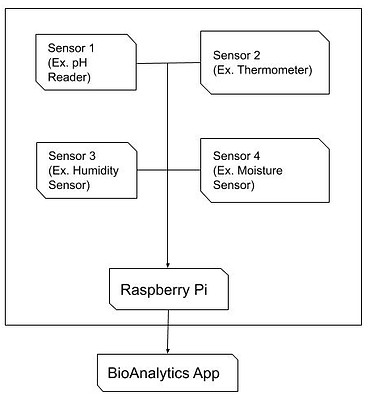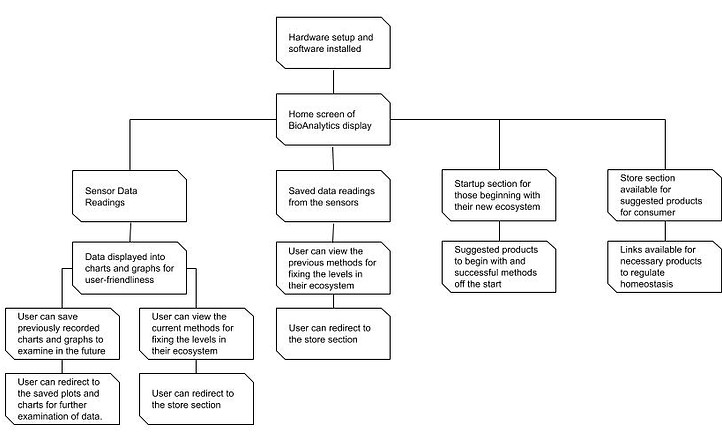Engineering Design VI Final Project - Biosystems Management
[Final Portion Not Published Yet.. Coming Very Soon]
EXERCISE 2 - NEEDS ASSESSMENT
-
Objective
-
Create an application that monitors environmental information and records the data.
-
-
Background
-
From what I've gathered, miniature ecosystems within a household, such as terrariums and fish tanks, do not typically have sensory input to monitor all of the necessary levels to sustain the enclosed life. Many households have trouble maintaining their miniature ecosystems due to a failure to keep the levels necessary to maintain the homeostatic environment.
-
-
Methodology
-
The user will use their smartphone device to access the app, which will have sections for the monitored data, as well as feedback for corrective procedures. For example, if the pH of a tank became too high, the application could suggest adding buffer solutions to return the system to a safe level.
-
-
Expected Results
-
The use of this product will allow users to have longer life expectancies of their system. This same service can be utilized on a much larger scale by organizations focused on the wellbeing of wildlife kept in preserves and rescue facilities.
-
-
Cost
-
The software will cost time more than anything, as the backend and frontend development on the app can be produced in-house for free. The cost of the hardware will include the Raspberry Pi as well as a varying number of sensors depending on what the consumer requests. Ultimately this will cost slightly upwards of $100.
-
EXERCISE 3 - PROBLEM FORMULATION
-
Problem Statement
-
Most beginner and intermediate wildlife pet owners are not familiar with the excessive regulatory requirements of biosystems.
-
-
Real Problem
-
Adverse regulatory levels can be extremely detrimental to the organism's health. Almost all of the marketed ecosystems are not for beginner to intermediate owners, and the cost of those systems is unreasonably high.
-
PS-DS
-
Present State
-
Lack of knowledge and monitoring capabilities for ecosystems.
-
-
Desired State
-
Create a centralized system for data analysis and knowledge building.
-
Kepner-Tregoe
-
Timing
-
With a global pandemic that locked down most of the world, households are seeking new ways hobbies to fill the gaps. This application will provide all of the analytic needs to properly maintain their own ecosystem.
-
-
Trend
-
As of today, 13% of all American households have fish tanks while another 4.5% own reptiles, this isn't to mention the variety of other species involved with biosystems. The stability of this market provides a firm consumer base.
-
-
Impact
-
Consumers, especially beginners will be able to take up this hobby with minimal stress and increased security while also providing a wide knowledge base to perfect current situations and look into future investments.
-
Kepner-Tregoe Problem Analysis
-
What
-
Beginner biosystems operators may struggle to keep up with regulatory conditions. For example, fish tanks must have specific levels of ammonia and nitrates.
-
-
When
-
Those who are just beginning on their biosystems journey or those who have realized the deceptive amount of time and attention needed will both find comfort in the functionality of this product.
-
-
Who
-
Anyone looking for or owning a biosystem wanting to make their lives easier along with promoting health to the organism they possess.
-
-
Where
-
Any biosystems, the initial product however will be aimed at household biosystems, filling the niche of cost-friendly, small-scale monitoring systems.
-
-
Why
-
Resolving the headaches that can arise from these biosystems allows the user to really appreciate the beauty of their possession along with the enjoyment it brings.
-
-
How
-
This stems from the uneducated jump into this hobby where consumers spend hundreds to thousands of dollars creating their biological masterpieces just to lose all the enclosed organisms to easily resolvable but invisible regulatory flaws.
-
EXERCISE 4 - SOLUTION DEVELOPMENT
Design Tasks
-
Design a compact unit that combines a Raspberry Pi to sensors based on the consumer and their biosystem. Aquatic environments may monitor regulatory components such as pH, ammonia concentration, nitrate levels, and so forth, whereas the land-based terrariums may monitor moisture, temperature, oxygen levels, etc.
-
Design an app to display the information from the unit, i.e levels in real-time, warnings, corrective courses, and reminders as well as a database that contains generalized biosystems knowledge as well as more specific species dependant information.
-
Learn the code for the hardware unit to project the readings onto the application, as well as the code for the application.
Design Goals/Specifications
-
The Hardware unit should be compact so as not to draw the eye from the enclosure itself.
-
Cost for hardware unit must be sub $100 and the app will be free or low price with possible paid content.
EXERCISE 5 - INTELLECTUAL PROPERTIES
BioAnalytics is a name that is not used by any company but is rather a word used to define the chemical analysis of biosystems, regardless of whether those systems are closed or not. Bioanalytics is used in many different fashions, because the somewhat broad term is used to define data analysis in fields such as healthcare, environmental science, pharmaceutical sciences, etc. The terminology 'BioAnalytics' is available to the trademark for use for the product.
EXERCISE 6 - ABSTRACT AND MODELING
Process Model System Model


EXERCISE 7 - SYNTHESIS
Goals:
-
Achieve enough water resistance necessary for the hardware
-
Make the design as compact as possible
-
Design the app to have a friendly user-interface
Methods to Achieve Goals:
-
Water-resistance/proofing may require sheltering as opposed to waterproofing the unit directly. All data sensors can mostly be connected directly to the Pi, however, if a mountable breadboard is needed then it can be mounted to the casing on the Pi.
-
A compact design is idealized so as not to detract from the biosystem aesthetic with wires and data sensors.
-
Research can be conducted as to how easy customers feel the app tends to be, and adjustments can be made from there.
EXERCISE 8 - ETHICS AND LIABILITY
In general, not much risk is associated with the product. The baseline version of the app is free with no card necessary on file for the app. It is possible that anyone who opts to pay for the additional components of the application could have their card information stolen by someone with the means to hack the app. Other than that, the software can simply be installed and uninstalled from the consumers' phones. The risk with the hardware is certainly more prevalent. The first risk is a misstep when waterproofing the hardware. This could result in short-circuiting of the system, as water (specifically impure water) is conductive for electricity due to the ions present in the water. A secondary risk for the hardware is a malfunction in the setup that could send electricity into the ecosystem that it is supposed to be monitoring. If this is an aquatic environment that would be especially detrimental considering that electricity would be sent through the organisms present in the system.
EXERCISE 9 - FAILURE AND HAZARD ANALYSIS
Apart from a hazard analysis for the user so no harm comes to the consumer from the electrical system, we must ensure that the sensors get recalibrated periodically so the application does not make misinformed suggestions on the chemical components that need to be added to maintain a safe homeostatic environment.
